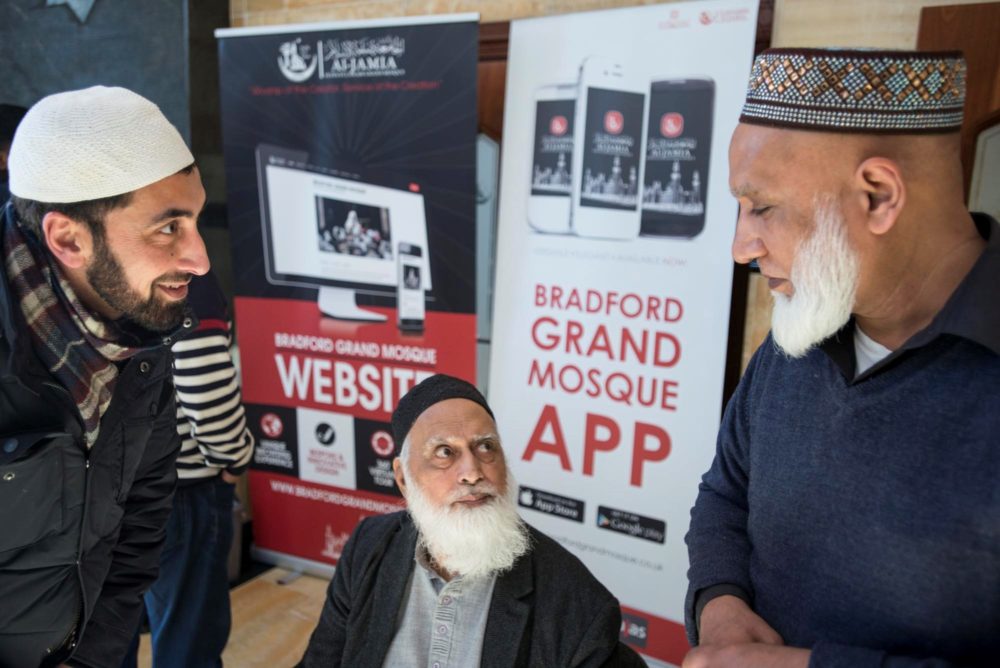
Seán McLoughlin
Six months into the Bradford’s National Museum Project a casual, end-of-workshop exchange prompted a ‘light-bulb’ moment of realisation that ‘buy-in’ from staff across an institution as large and complex as the National Science and Media Museum could not be taken for granted even after a long process of preparation. As a visiting researcher from the University of Leeds, I was still trying to work out the differences between various museum roles and where there might be experience and capacity in terms of public engagement with minoritised groups.

The ‘Islamic Soundscapes in Bradford’ exhibit collective, Above the Noise launch, March 2019. Image credit: Anna Bridson for National Science and Media Museum / Science Museum Group
Then, as part of a Curatorial Group established in Summer 2018, I spoke with representatives of local Muslim organisations about the idea of using a National Science and Media Museum / Bradford’s National Museum Project Spring 2019 exhibition to better connect the museum to Bradford and especially its diaspora communities. However, such conversations typically revealed clear reservations about getting involved. Previous experiences of National Science and Media Museum outreach had left a residual wariness of mismatched concerns and a desire to assume much greater ownership of projects and their curation.

Bradford Grand Mosque, February 2019. Image credit: Tim Smith
However, during my first visit to one of the city’s largest mosques, I discovered by chance that a member of NSMM staff – someone I hadn’t yet met – had independently taken the initiative to arrange a guided tour there for a few museum staff. As ideas for an exhibit on ‘Islamic soundscapes in Bradford’ were explored, and eventually plans were made for expert sound recordings of daily and weekly rituals, they also made it their business to return the mosque’s hospitality and warmly hosted 40 of its students at the museum. They were eager to participate, too, when local women were inducted as volunteer researchers to investigate how changing technologies have mediated Islamic sounds in the trans-locally connected lives of their families and friends.

‘Co-producing research on Islamic Soundscapes’ workshop, National Science and Media Museum, December 2018. Image credit: Wahida Shaffi
Yet, a follow-up conversation between us also revealed a ‘live’ concern that the museum’s institutional culture was ill-prepared for the idea that religion, and perhaps especially Islam, is an equality, diversity and inclusion issue in the workplace. Majority British society often frames ‘religion’ in terms of deeply-held, private (and usually ‘conservative’) ‘faith’ and ‘belief’. Liberals can be insensitive to – or anxious about – its recognition and display in supposedly neutral, secular spaces. Yet, such an approach unhelpfully abstracts ‘religion’ from its everyday local and national settings and fails to appreciate its intersection with ‘race’ and ‘ethnicity’ in constructions of ‘minority difference’. ‘Islamophobia’, for instance, can best be seen as a form of majority cultural racism and social exclusion which – since at least the Rushdie Affair in 1989 and especially since ‘9/11’ and the London bombings – has treated people of ‘Muslim’ background as a distinctive ethno-racial group and attributed essential characteristics to their ‘Muslimness’.

Members of Bradford Grand Mosque’s congregation with its App advertised in the background, February 2019. Image credit: Tim Smith Photos
It seemed very significant, then, that during Above the Noise: 15 Stories from Bradford the ‘Islamic soundscapes’ exhibit could be seen and heard – temporarily at least – on the stage of a National Science and Media Museum gallery. The beauty of its sounds and testimonies excited awe and interest but also instances of anti-Muslim racism. Signposting a globally connected world of everyday Islamic practices mediated by sound and vision technologies literally steps from the museum, the exhibit reflected how Bradford’s soundscape has been transformed since the 1960s. However, in a district where nearly one-quarter of the population (24.7%) identifies as Muslim and in a city where Muslims’ struggles for public recognition are four decades old, the pressing question now is how such ‘(trans)local knowledge’ can become systemically embodied in the National Science and Media Museum? At a time when cultural organisations worldwide are reflecting on why ‘race’ matters, its location in Bradford means that the museum has a unique responsibility to engage with the complexities and realities of racially-ethnically-religiously marked exclusion but also the multiple ways in which minoritised individuals and groups creatively organise their lives beyond the gaze of majority excluders.

Signposting a trans-locally connected world of rooted Muslim practices mediated by sound and vision technologies, ‘Islamic Soundscapes in Bradford’, Above the Noise launch, March 2019. Image credit: Anna Bridson for the National Science and Media Museum / Science Museum Group
Seán McLoughlin's bio
I am Professor of the Anthropology of Islam at the University of Leeds and Co-Investigator on the Bradford’s National Museum Project (BNMP, 2017-21). I was a member of the Curatorial Group for the 2019 Science and Media Museum exhibition Above the Noise: 15 Stories from Bradford and led on articulating the relationships between changing sound and vision technologies and Bradford’s trans-local connections to people and places elsewhere, especially Pakistan and the wider Muslim world. I built relationships with local people and institutions, co-produced participatory ethnographic research with them and co-curated the ‘Islamic Soundscapes’ and ‘Fast FM’ stories.
In general my work seeks to prioritise the ‘bottom-up’ perspectives of people’s everyday lives at the grassroots, and highlight the gaps between this and the logics of ‘mainstream’ institutions and governance. Building on an investigation of how postcolonial Bradford (2006) has been written about since the 1960s, in Writing the City in British Asian Diasporas (2014) I explore — with BNMP Co-Investigator William Gould and others — how migration and post-migration communities’ cultural production gives agency and voice to social realities often erased in dominant policy and media discourses. This approach also informed the development of Above the Noise, having previously led to a Being Human Festival event co-curated with Bradford Literature Festival (2015) which involved some of the BNMP’s future partners.



